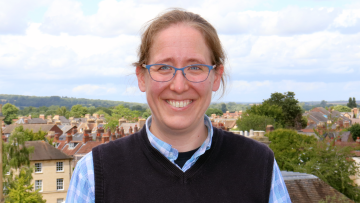Congratulations to Vicky who will take up the position in 2024. Vicky is the Whitehead Lecturer at the Mathematical Institute and Balliol College and also a Supernumerary Fellow at Balliol College.
Alongside her teaching, Vicky's role is to discuss mathematics with a broader audience via public lectures, talks and workshops in schools as well as mathematical summer schools for teenagers, notably PROMYS Europe for which she is Executive Director.
16:00
Constructing CFTs
Abstract
Since Segal's formulation of axioms for 2d CFTs in the 80s, it has remained a major problem to construct examples of CFTs that satisfy the axioms.
I will report on ongoing joint work with James Tener in that direction.
16:00
A quantization of coarse structures and uniform Roe algebras
Abstract
A coarse structure is a way of talking about "large-scale" properties. It is encoded in a family of relations that often, but not always, come from a metric. A coarse structure naturally gives rise to Hilbert space operators that in turn generate a so-called uniform Roe algebra.
In work with Bruno Braga and Joe Eisner, we use ideas of Weaver to construct "quantum" coarse structures and uniform Roe algebras in which the underlying set is replaced with an arbitrary represented von Neumann algebra. The general theory immediately applies to quantum metrics (suitably defined), but it is much richer. We explain another source based on measure instead of metric, leading to the new, large, and easy-to-understand class of support expansion C*-algebras.
I will present the big picture: where uniform Roe algebras come from, how Weaver's framework facilitates our definitions. I will focus on a few illustrative examples and will not presume familiarity with coarse structures or von Neumann algebras.
16:00
Injective factors arising as discrete quantum group von Neumann algebras
Abstract
It is well known that if a group von Neumann algebra of a (nontrivial) discrete group is a factor, then it is a factor of type II_1. During the talk, I will answer the following question: which types appear as types of injective factors being group von Neumann algebras of discrete quantum groups (or looking from the dual perspective - von Neumann algebras of bounded functions on compact quantum groups)? An important object in our work is the subgroup of real numbers t for which the scaling automorphism tau_t is inner. This is joint work with Piotr Sołtan.
16:00
Interacting Systems – where Analysis, PDEs and Probability meet
Abstract
We are surrounded by systems that involve many elements and the interactions between them: the air we breathe, the galaxies we watch, herds of animals roaming the African planes and even us – trying to decide on whom to vote for.
As common as such systems are, their mathematical investigation is far from simple. Motivated by the realisation that in most cases we are not truly interested in the individual behaviour of each and every element of the system but in the average behaviour of the ensemble and its elements, a new approach emerged in the late 1950s - the so-called mean field limits approach. The idea behind this approach is fairly intuitive: most systems we encounter in real life have some underlying pattern – a correlation relation between its elements. Giving a mathematical interpretation to a given phenomenon and its emerging pattern with an appropriate master/Liouville equation, together with such correlation relation, and taking into account the large number of elements in the system results in a limit equation that describes the behaviour of an average limit element of the system. With such equation, one hopes, we could try and understand better the original ensemble.
In our talk we will give the background to the formation of the ideas governing the mean field limit approach and focus on one of the original models that motivated the birth of the field – Kac’s particle system. We intend to introduce Kac’s model and its associated (asymptotic) correlation relation, chaos, and explore attempts to infer information from it to its mean field limit – The Boltzmann-Kac equation.
16:00
Selected aspects of the dynamical Kirchberg-Phillips theorem
Abstract
I will start this talk with a brief introduction and summary of the outcome of a joint work with James Gabe. An important special case of the main result is that for any countable discrete amenable group G, any two outer G-actions on stable Kirchberg algebras are cocycle conjugate precisely when they are equivariantly KK-equivalent. In the main body of the talk, I will outline the key arguments toward a special case of the 'uniqueness theorem', which is one of the fundamental ingredients in our theory: Suppose we have two G-actions on A and B such that B is a stable Kirchberg algebra and the action on B is outer and equivariantly O_2-absorbing. Then any two cocycle embeddings from A to B are approximately unitarily equivalent. If time permits, I will provide a (very rough) sketch of how this leads to the dynamical O_2-embedding theorem, which implies that such cocycle embeddings always exist in the first place.
16:00
Quantum limits
Abstract
In this talk, I will discuss the notion of quantum limits from different viewpoints: Cordes' work on the Gelfand theory for pseudo-differential operators dating from the 70’s as well as the micro-local defect measures and semi-classical measures of the 90’s. I will also explain my motivation and strategy to obtain similar notions in subRiemannian or subelliptic settings.


